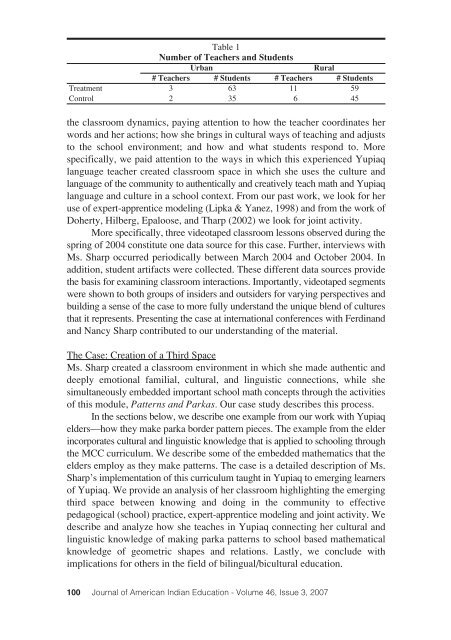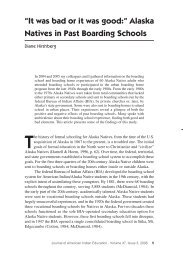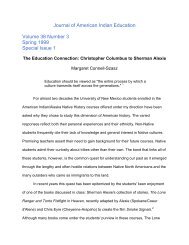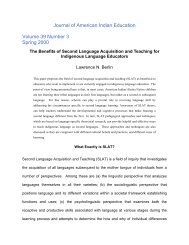Examples from Math in a Cultural Context - Journal of American ...
Examples from Math in a Cultural Context - Journal of American ...
Examples from Math in a Cultural Context - Journal of American ...
Create successful ePaper yourself
Turn your PDF publications into a flip-book with our unique Google optimized e-Paper software.
Table 1Number <strong>of</strong> Teachers and StudentsUrbanRural# Teachers # Students # Teachers # StudentsTreatment 3 63 11 59Control 2 35 6 45the classroom dynamics, pay<strong>in</strong>g attention to how the teacher coord<strong>in</strong>ates herwords and her actions; how she br<strong>in</strong>gs <strong>in</strong> cultural ways <strong>of</strong> teach<strong>in</strong>g and adjuststo the school environment; and how and what students respond to. Morespecifically, we paid attention to the ways <strong>in</strong> which this experienced Yupiaqlanguage teacher created classroom space <strong>in</strong> which she uses the culture andlanguage <strong>of</strong> the community to authentically and creatively teach math and Yupiaqlanguage and culture <strong>in</strong> a school context. From our past work, we look for heruse <strong>of</strong> expert-apprentice model<strong>in</strong>g (Lipka & Yanez, 1998) and <strong>from</strong> the work <strong>of</strong>Doherty, Hilberg, Epaloose, and Tharp (2002) we look for jo<strong>in</strong>t activity.More specifically, three videotaped classroom lessons observed dur<strong>in</strong>g thespr<strong>in</strong>g <strong>of</strong> 2004 constitute one data source for this case. Further, <strong>in</strong>terviews withMs. Sharp occurred periodically between March 2004 and October 2004. Inaddition, student artifacts were collected. These different data sources providethe basis for exam<strong>in</strong><strong>in</strong>g classroom <strong>in</strong>teractions. Importantly, videotaped segmentswere shown to both groups <strong>of</strong> <strong>in</strong>siders and outsiders for vary<strong>in</strong>g perspectives andbuild<strong>in</strong>g a sense <strong>of</strong> the case to more fully understand the unique blend <strong>of</strong> culturesthat it represents. Present<strong>in</strong>g the case at <strong>in</strong>ternational conferences with Ferd<strong>in</strong>andand Nancy Sharp contributed to our understand<strong>in</strong>g <strong>of</strong> the material.The Case: Creation <strong>of</strong> a Third SpaceMs. Sharp created a classroom environment <strong>in</strong> which she made authentic anddeeply emotional familial, cultural, and l<strong>in</strong>guistic connections, while shesimultaneously embedded important school math concepts through the activities<strong>of</strong> this module, Patterns and Parkas. Our case study describes this process.In the sections below, we describe one example <strong>from</strong> our work with Yupiaqelders—how they make parka border pattern pieces. The example <strong>from</strong> the elder<strong>in</strong>corporates cultural and l<strong>in</strong>guistic knowledge that is applied to school<strong>in</strong>g throughthe MCC curriculum. We describe some <strong>of</strong> the embedded mathematics that theelders employ as they make patterns. The case is a detailed description <strong>of</strong> Ms.Sharp’s implementation <strong>of</strong> this curriculum taught <strong>in</strong> Yupiaq to emerg<strong>in</strong>g learners<strong>of</strong> Yupiaq. We provide an analysis <strong>of</strong> her classroom highlight<strong>in</strong>g the emerg<strong>in</strong>gthird space between know<strong>in</strong>g and do<strong>in</strong>g <strong>in</strong> the community to effectivepedagogical (school) practice, expert-apprentice model<strong>in</strong>g and jo<strong>in</strong>t activity. Wedescribe and analyze how she teaches <strong>in</strong> Yupiaq connect<strong>in</strong>g her cultural andl<strong>in</strong>guistic knowledge <strong>of</strong> mak<strong>in</strong>g parka patterns to school based mathematicalknowledge <strong>of</strong> geometric shapes and relations. Lastly, we conclude withimplications for others <strong>in</strong> the field <strong>of</strong> bil<strong>in</strong>gual/bicultural education.100 <strong>Journal</strong> <strong>of</strong> <strong>American</strong> Indian Education - Volume 46, Issue 3, 2007





